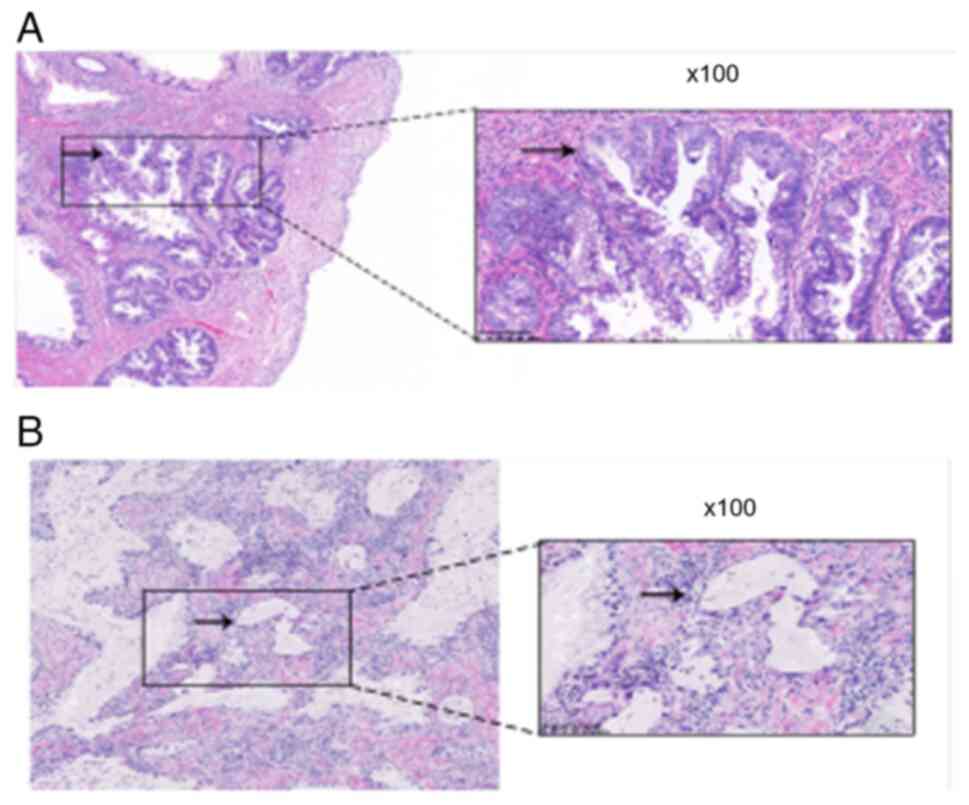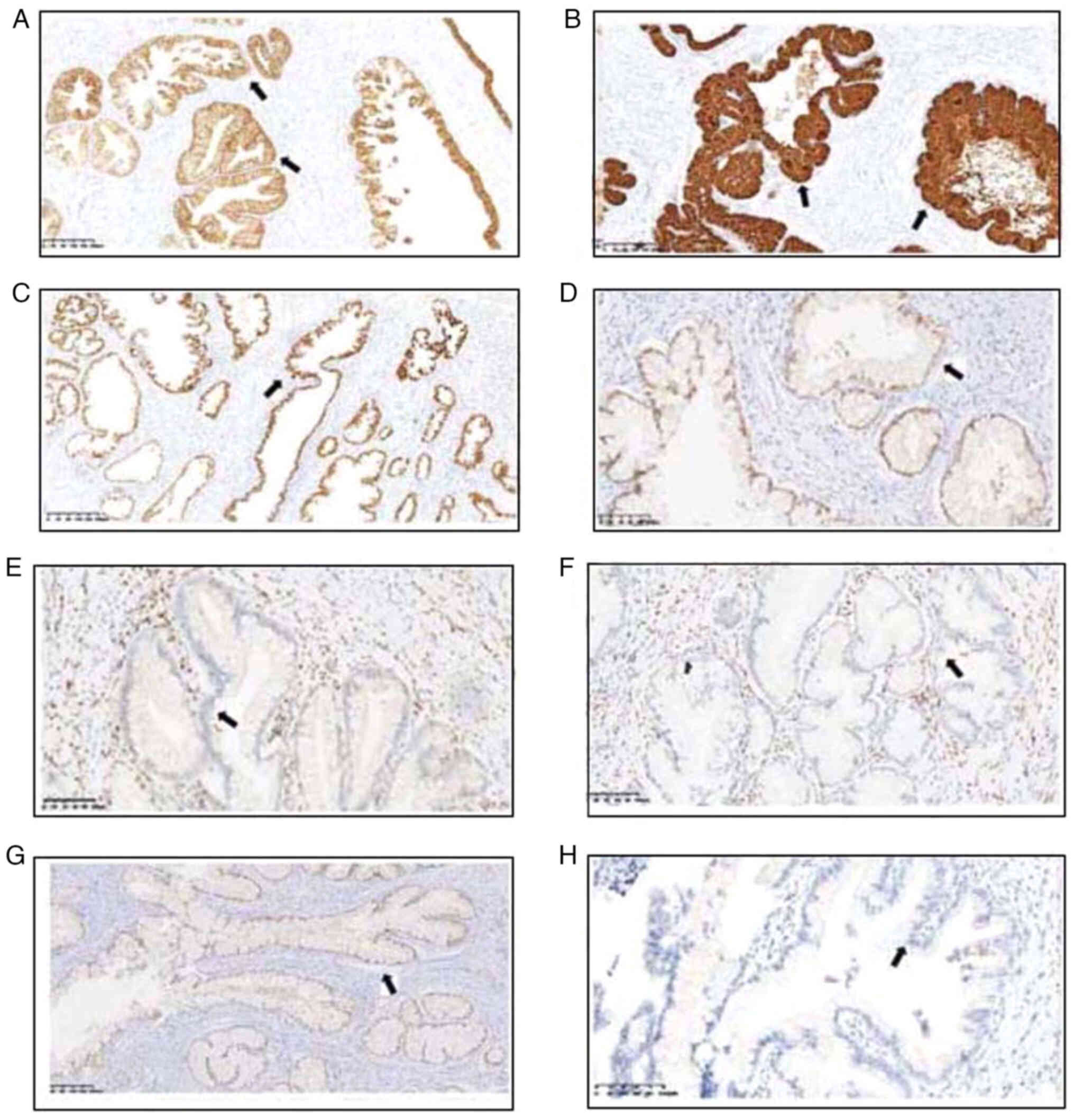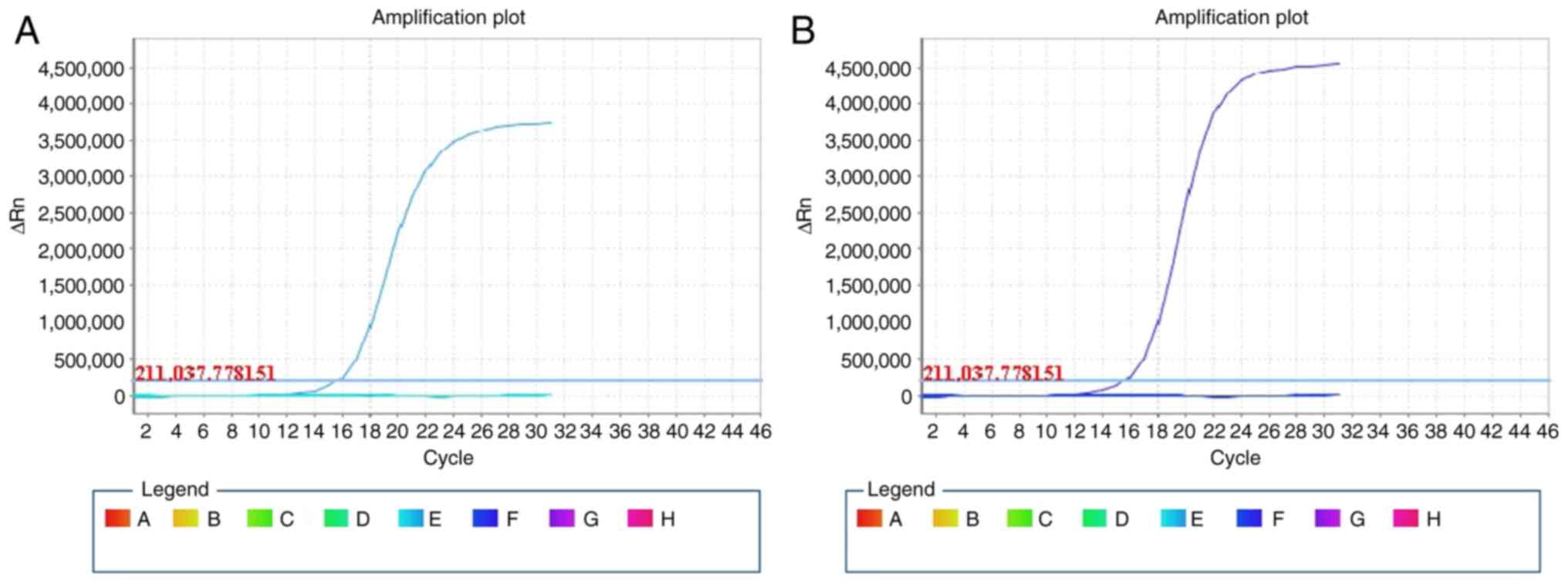|
1
|
Adegoke O, Kulasingam S and Virnig B:
Cervical cancer trends in the United States: A 35-year
population-based analysis. J Womens Health (Larchmt). 21:1031–1037.
2012. View Article : Google Scholar : PubMed/NCBI
|
|
2
|
Guo F, Cofie LE and Berenson AB: Cervical
cancer incidence in young U.S. females after human papillomavirus
vaccine introduction. Am J Prev Med. 55:197–204. 2018. View Article : Google Scholar : PubMed/NCBI
|
|
3
|
Bewley S: HPV vaccination and cervical
cancer screening. Lancet. 399:19392022. View Article : Google Scholar : PubMed/NCBI
|
|
4
|
Michels KB and zur Hausen H: HPV vaccine
for all. Lancet. 374:268–270. 2009. View Article : Google Scholar : PubMed/NCBI
|
|
5
|
Paavonen J, Naud P, Salmerón J, Wheeler
CM, Chow SN, Apter D, Kitchener H, Castellsague X, Teixeira JC,
Skinner SR, et al: Efficacy of human papillomavirus (HPV)-16/18
AS04-adjuvanted vaccine against cervical infection and precancer
caused by oncogenic HPV types (PATRICIA): Final analysis of a
double-blind, randomised study in young women. Lancet. 374:301–314.
2009. View Article : Google Scholar : PubMed/NCBI
|
|
6
|
Cree IA, White VA, Indave BI and Lokuhetty
D: Revising the WHO classification: Female genital tract tumours.
Histopathology. 76:151–156. 2020. View Article : Google Scholar : PubMed/NCBI
|
|
7
|
Kojima A, Mikami Y, Sudo T, Yamaguchi S,
Kusanagi Y, Ito M and Nishimura R: Gastric morphology and
immunophenotype predict poor outcome in mucinous adenocarcinoma of
the uterine cervix. Am J Surg Pathol. 31:664–672. 2007. View Article : Google Scholar : PubMed/NCBI
|
|
8
|
Mikami Y and McCluggage WG: Endocervical
glandular lesions exhibiting gastric differentiation: An emerging
spectrum of benign, premalignant and malignant lesions. Adv Anat
Pathol. 20:227–237. 2013. View Article : Google Scholar : PubMed/NCBI
|
|
9
|
Carpenter KM, Durrant LG, Morgan K,
Bennett D, Hardcastle JD and Kalsheker NA: Greater frequency of
K-ras Val-12 mutation in colorectal cancer as detected with
sensitive methods. Clin Chem. 42 (6 Pt 1):904–909. 1996. View Article : Google Scholar : PubMed/NCBI
|
|
10
|
Hruban RH, van Mansfeld AD, Offerhaus GJ,
van Weering DH, Allison DC, Goodman SN, Kensler TW, Bose KK,
Cameron JL and Bos JL: K-ras oncogene activation in adenocarcinoma
of the human pancreas. A study of 82 carcinomas using a combination
of mutant-enriched polymerase chain reaction analysis and
allele-specific oligonucleotide hybridization. Am J Pathol.
143:545–554. 1993.PubMed/NCBI
|
|
11
|
Staratschek-Jox A, Kotkowski S, Belge G,
Rudiger T, Bullerdiek J, Diehl V and Wolf J: Detection of
Epstein-Barr Virus in Hodgkin-ReedSternberg Cells: No evidence for
the persistence of integrated viral fragments inLatent membrane
protein-1 (LMP-1)-negative classical Hodgkin's disease. Am J
Pathol. 156:209–216. 2000. View Article : Google Scholar : PubMed/NCBI
|
|
12
|
Carleton C, Hoang L, Sah S, Kiyokawa T,
Karamurzin YS, Talia KL, Park KJ and McCluggage WG: A detailed
immunohistochemical analysis of a large series of cervical and
vaginal gastric-type adenocarcinomas. Am J Surg Pathol. 40:636–644.
2016. View Article : Google Scholar : PubMed/NCBI
|
|
13
|
Zhao S, Hayasaka T, Osakabe M, Kato N,
Nakahara K, Kurachi H, Fukase M, Katayama Y, Yaegashi N and
Motoyama T: Mucin expression in nonneoplastic and neoplastic
glandular epithelia of the uterine cervix. Int J Gynecol Pathol.
22:393–397. 2003. View Article : Google Scholar : PubMed/NCBI
|
|
14
|
Fan XY, Hu ZY, Xu FH, Yan ZQ, Guo SQ and
Li ZM: Rapid Detection of rpoB gene mutations in rifampin-resistant
mycobacterium tuberculosis isolates in shanghai by using the
amplification refractory mutation system. J Clin Microbiol.
41:993–997. 2003. View Article : Google Scholar : PubMed/NCBI
|
|
15
|
Levine AJ, Hu W and Feng Z: The P53
pathway: What questions remain to be explored? Cell Death Differ.
13:1027–1036. 2006. View Article : Google Scholar : PubMed/NCBI
|
|
16
|
Muller PA and Vousden KH: p53 mutations in
cancer. Nat Cell Biol. 15:2–8. 2013. View
Article : Google Scholar : PubMed/NCBI
|
|
17
|
Talia KL and McCluggage WG: The developing
spectrum of gastric-type cervical glandular lesions. Pathology.
50:122–133. 2018. View Article : Google Scholar : PubMed/NCBI
|
|
18
|
Park KJ: Cervical adenocarcinoma:
Integration of HPV status, pattern of invasion, morphology and
molecular markers into classification. Histopathology. 76:112–127.
2020. View Article : Google Scholar : PubMed/NCBI
|
|
19
|
Ishii K, Hosaka N, Toki T, Momose M,
Hidaka E, Tsuchiya S and Katsuyama T: A new view of the so-called
adenoma malignum of the uterine cervix. Virchows Arch. 432:315–322.
1998. View Article : Google Scholar : PubMed/NCBI
|
|
20
|
Chou YY, Lin MC and Huang LW: Human
papillomavirus-unrelated gastric type of cervical adenocarcinoma
presenting with a metastatic ovarian tumor: Report of a case. J Low
Genit Tract Dis. 17:218–222. 2013. View Article : Google Scholar : PubMed/NCBI
|
|
21
|
Karamurzin YS, Kiyokawa T, Parkash V,
Jotwani AR, Patel P, Pike MC, Soslow RA and Park KJ: Gastric-type
endocervical adenocarcinoma. An aggressive tumor with unusual
metastatic patterns and poor prognosis. Am J Surg Pathol.
39:1449–1457. 2015. View Article : Google Scholar : PubMed/NCBI
|
|
22
|
Toki T, Shiozawa T, Hosaka N, Ishii K,
Nikaido T and Fujii S: Minimal deviation adenocarcinoma of the
uterine cervix has abnormal expression of sex steroid receptors,
CA125, and gastric mucin. Int J Gynecol Pathol. 16:111–116. 1997.
View Article : Google Scholar : PubMed/NCBI
|
|
23
|
Li H, Jing X, Yu J, Liu J, Zhang T, Chen S
and Zhang X: A combination of cytokeratin 5/6, p63, p40 and MUC5AC
are useful for distinguishing squamous cell carcinoma from
adenocarcinoma of the cervix. Diagn Pathol. 15:1042020. View Article : Google Scholar : PubMed/NCBI
|
|
24
|
Riethdorf L, O'Connell JT, Riethdorf S,
Cviko A and Crum CP: Differential expression of MUC2 and MUC5AC in
benign and malignant glandular lesions of the cervix uteri.
Virchows Arch. 437:365–371. 2000. View Article : Google Scholar : PubMed/NCBI
|
|
25
|
Hebbar V, Damera G and Sachdev GP:
Differential expression of MUC genes in endometrial and cervical
tissues and tumors. BMC Cancer. 5:1242005. View Article : Google Scholar : PubMed/NCBI
|
|
26
|
Gilks CB, Young RH, Aguirre P, DeLellis RA
and Scully R: Adenoma malignum (minimal deviation adenocarcinoma)
of the uterine cervix. A clinicopathological and
immunohistochemical analysis of 26 cases. Am J Surg Pathol.
13:717–729. 1989. View Article : Google Scholar : PubMed/NCBI
|
|
27
|
McCluggage WG, Shah R, Connolly LE and
McBride HA: Intestinal-type cervical adenocarcinoma in situ and
adenocarcinoma exhibit a partial enteric immunophenotype with
consistent expression of CDX2. Int J Gynecol Pathol. 27:92–100.
2008. View Article : Google Scholar : PubMed/NCBI
|
|
28
|
Patel SP and Kurzrock R: PD-L1 expression
as a predictive biomarker in cancer immunotherapy. Mol Cancer Ther.
14:847–856. 2015. View Article : Google Scholar : PubMed/NCBI
|
|
29
|
Laury AR, Perets R, Piao H, Krane JF,
Barletta JA, French C, Chirieac LR, Lis R, Loda M, Hornick JL, et
al: A comprehensive analysis of PAX8 expression in human epithelial
tumors. Am J Surg Pathol. 35:816–826. 2011. View Article : Google Scholar : PubMed/NCBI
|
|
30
|
Yemelyanova A, Gown AM, Wu LS, Holmes BJ,
Ronnett BM and Vang R: PAX8 expression in uterine adenocarcinomas
and mesonephric proliferations. Int J Gynecol Pathol. 33:492–499.
2014. View Article : Google Scholar : PubMed/NCBI
|












